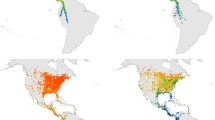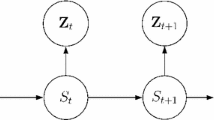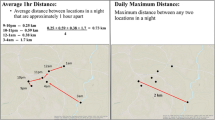Abstract
Contemporary ecologists often find themselves with an overwhelming amount of data to analyze. For example, it is now possible to collect nearly continuous spatiotemporal data on animal locations via global positioning systems and other satellite telemetry technology. In addition, there is a wealth of readily available environmental data via geographic information systems and remote sensing. We present a modeling framework that utilizes these forms of data and builds on previous research pertaining to the quantitative analysis of animal movement. This approach provides additional insight into the environmental drivers of residence and movement as well as resource selection while accommodating path uncertainty. The methods are demonstrated in an application involving mule deer movement in the La Sal Range, Utah, USA. Supplemental materials for this article are available online.
Similar content being viewed by others
References
Albert, J. H., and Chib, S. (1993), “Bayesian Analysis of Binary and Polychotomous Response Data,” Journal of the American Statistical Association, 88, 669–679.
Barraquand, F., and Benhamou, S. (2008), “Animal Movements in Heterogeneous Landscapes: Identifying Profitable Places and Homogeneous Movement Bouts,” Ecology, 89, 3336–3348.
Christ, A., Ver Hoef, J., and Zimmerman, D. L. (2008), “An Animal Movement Model Incorporating Home Range and Habitat Selection,” Environmental and Ecological Statistics, 15, 27–38.
Cressie, N. A. C., Calder, C. A., Clark, J. S., Ver Hoef, J. M., and Wikle, C. K. (2009), “Accounting for Uncertainty in Ecological Analysis: The Strengths and Limitations of Hierarchical Statistical Modeling,” Ecological Applications, 19, 553–570.
D’Eon, R. G., and Serrouya, R. (2005), “Mule Deer Seasonal Movements and Multiscale Resource Selection Using Global Positioning System Radiotelemetry,” Journal of Mammology, 86, 736–744.
Eckert, S. A., Moore, J. E., Dunn, D. C., Sagarminaga Van Buiten, R., Eckert, K. L., and Halpin, P. N. (2008), “Modeling Loggerhead Turtle Movement in the Mediterranean: Importance of Body Size and Oceanography,” Ecological Applications, 18, 290–308.
Flegal, J. M., Haran, M., and Jones, G. L. (2008), “Markov Chain Monte Carlo: Can We Trust the Third Significant Figure?” Statistical Science, 23, 250–260.
Grimm, V., and Railsback, S. F. (2005), Individual-Based Modeling and Ecology, Princeton, New Jersey: Princeton University Press.
Grimm, V., Revilla, E., Berger, U., Jeltsch, F., Mooij, W. M., Railsback, S. F., Thulke, H.-H., Weiner, J., Wiegand, T., and DeAngelis, D. L. (2005), “Pattern-Oriented Modeling of Agent-Based Complex Systems: Lessons from Ecology,” Science, 310, 987–991.
Holyoak, M., Casagrandi, R., Nathan, R., Revilla, E., and Spiegel, O. (2008), “Trends and Missing Parts in the Study of Movement Ecology,” Proceedings of the National Academy of Sciences, 105, 19060–19065.
Homer, C., Dewitz, J., Fry, J., Coan, M., Hossain, N., Larson, C., Herold, N., McKerrow, A., VanDriel, J. N., and Wickham, J. (2007), “Completion of the 2001 National Land Cover Database for the Conterminous United States,” Photogrammetric Engineering and Remote Sensing, 73, 337–341.
Hooten, M. B., and Wikle, C. K. (2010), “Statistical Agent-Based Models for Discrete Spatiotemporal Systems,” Journal of the American Statistical Association, 105, 236–248.
Horne, J. S., Garton, E. O., Krone, S. M., and Lewis, J. S. (2007), “Analyzing Animal Movements Using Brownian Bridges,” Ecology, 88, 2354–2363.
Johnson, D. S., London, J. M., Lea, M.-A., and Durban, J. W. (2008), “Continuous-Time Correlated Random Walk Model for Animal Telemetry Data,” Ecology, 89, 1208–1215.
Jones, G. L., Haran, M., Caffo, B. S., and Neath, R. (2006), “Fixed-Width Output Analysis for Markov Chain Monte Carlo,” Journal of the American Statistical Association, 101, 1537–1547.
Jonsen, I. D., Myers, R. A., and Flemming, J. M. (2003), “Meta-Analysis of Animal Movement Using State-Space Models,” Ecology, 84, 3055–3063.
Jonsen, I. D., Flemming, J. M., and Myers, R. A. (2005), “Robust State-Space Modeling of Animal Movement Data,” Ecology, 86, 2874–2880.
MacKenzie, D. I., Nichols, J. D., Lachman, G. B., Droege, S., Royle, J. A., and Langtimm, C. A. (2002), “Estimating Site Occupancy Rates when Detection Probabilities are Less than One,” Ecology, 83, 2248–2255.
MacKenzie, D. I., Nichols, J. D., Hines, J. E., Knutson, M. G., and Franklin, A. B. (2003), “Estimating Site Occupancy, Colonization, and Local Extinction when a Species is Detected Imperfectly,” Ecology, 84, 2200–2207.
McFarlane, L. R. (2007), “Breeding Behavior and Space Use of Male and Female Mule Deer: An Examination of Potential Risk Differences for Chronic Wasting Disease Infection,” M.S. Thesis, Utah State University, Dept. of Wildland Resources.
Miller, M. W., Hobbs, N. T., and Tavener, S. J. (2006), “Dynamics of Prion Disease Transmission in Mule Deer,” Ecological Applications, 16, 2208–2214.
Morales, J. M., Haydon, D. T., Frair, J., Holsinger, K. E., and Fryxell, J. M. (2004), “Extracting More Out of Relocation Data: Building Movement Models as Mixtures of Random Walks,” Ecology, 85, 2436–2445.
O’Hara, R. B., and Sillanpaa, M. J. (2009), “A Review of Bayesian Variable Selection Methods: What, How and Which,” Bayesian Analysis, 4, 85–118.
Ramsey, F. L., and Usner, D. (2003), “Persistence and Heterogeneity in Habitat Selection Studies Using Radio Telemetry,” Biometrics, 59, 332–340.
Royle, J. A., and Dorazio, R. M. (2008), Hierarchical Modeling and Inference in Ecology: The Analysis of Data from Populations, Metapopulations and Communities, San Diego: Academic Press.
Royle, J. A., and Kery, M. (2007), “A Bayesian State-Space Formulation of Dynamic Occupancy Models,” Ecology, 88, 1813–1823.
Tanner, M. A., and Wong, W. H. (1987), “The Calculation of Posterior Distributions by Data Augmentation,” Journal of the American Statistical Association, 82, 528–540.
Tracey, J. A., Zhu, J., and Crooks, K. (2005), “A Set of Nonlinear Regression Models for Animal Movement in Response to a Single Landscape Feature,” Journal of Agricultural, Biological, and Environmental Statistics, 10, 1–18.
Tracey, J. A., Zhu, J., and Crooks, K. R. (2010, in press), “Modeling and Inference of Animal Movement Using Artificial Neural Networks,” Environmental and Ecological Statistics. doi:10.1007/s10651-010-0138-8.
Turchin, P. (1991), “Translating Foraging Movements in Heterogeneous Environments into the Spatial Distribution of Foragers,” Ecology, 72, 1253–1266.
— (1998), Quantitative Analysis of Movement, Sunderland, Massachusetts: Sinauer Associates, Inc. Publishers.
Wikle, C. K. (2003), “Hierarchical Bayesian Models for Predicting the Spread of Ecological Processes,” Ecology, 84, 1382–1394.
Xie, Y., and Carlin, B. (2006), “Measures of Bayesian Learning and Identifiability in Hierarchical Models,” Journal of Statistical Planning and Inference, 136, 3458–3477.
Author information
Authors and Affiliations
Corresponding author
Electronic Supplementary Material
Rights and permissions
About this article
Cite this article
Hooten, M.B., Johnson, D.S., Hanks, E.M. et al. Agent-Based Inference for Animal Movement and Selection. JABES 15, 523–538 (2010). https://doi.org/10.1007/s13253-010-0038-2
Accepted:
Published:
Issue Date:
DOI: https://doi.org/10.1007/s13253-010-0038-2




